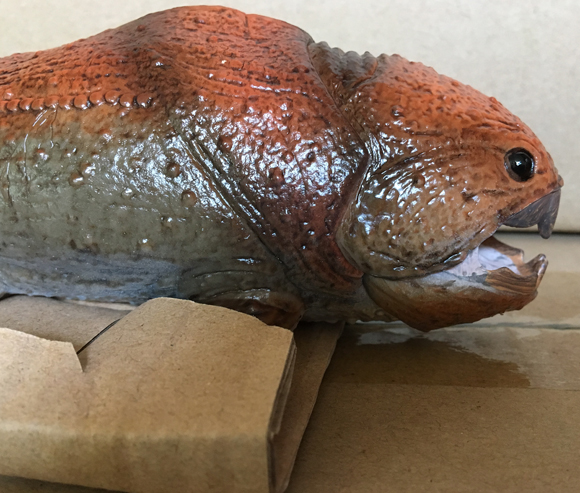Ancient Fish Found in Scottish Quarry
Devonian Fossil Fish Found in Scottish Quarry
A Scottish fish fossil that dates from the Devonian period has been unearthed in a disused flagstone quarry. The fish which has been identified as belonging to the genus named Actinolepis had not been known from UK strata before this discovery. Actinolepis was a placoderm (the name means “plated skins”). Placoderms were a class of jawed fish, protected by dermal armour around the head and front of the body. Originating sometime in the Ordovician, the group flourished throughout the Devonian but disappeared from the fossil record around 354 million years ago. The placoderms were one of the classes of vertebrates that went extinct at the end of the Devonian period.
Placoderm Fish Fossil
The only other example of an Actinolepis was found in Devonian strata in Estonia, making this Scottish fossil an important discovery.
During the Devonian period (approximately 417-354 million years ago), the landmasses that were to become North America, Scandinavia and Europe were joined together. The Eastern part of this super-continent was called Baltica, a mountain ridge had formed when continental plates had collided together (Laurentia colliding with Baltica to form a landmass called by many scientists – Euroamerica). Water draining from these uplands formed a huge, freshwater lake in the low lying areas of barren land between the mountains and the sea.
Lake Orcadie
This lake is called Lake Orcadie and at its peak it covered the land now occupied by Shetland, the Orkney, Caithness, the Moray coast and across to Norway. The lake seems to have existed for hundreds of thousands of years and during this time it went through a series of expansions and reductions in volume.
The lake contained a diverse variety of fish genera, with many of the fish being found as fossils in the quarry at Achanarras in Caithness, from which this new placoderm fossil was extracted. The quarry is now managed by Scottish Natural Heritage, so far sixteen different types of prehistoric fish fossil have been found at the site, including agnathans (jawless fish). It is not only fossil fish that makes this site so interesting fossils of many invertebrates that shared this watery world with the fish have also been found including fossils of eurypterids (sea-scorpions).
Professor Nigel Trewin
This latest discovery was officially unveiled by Aberdeen-based palaeontologist Nigel Trewin, who has been visiting the Achanarras quarry for more than 35 years. Professor Trewin, with colleague Mike Newman, has published details of this find in the Scottish Journal of Geology.
The actual fossil was found by an amateur collector, however, it was soon realised that this was an unusual and important find. Professor Trewin believed the fish, which had large pectoral fins, would have been a bottom feeder. Commenting on the demise of the placoderms, he said: “I’m afraid there are no modern relatives of this one, unlike some of the other finds which have been made here.”
The placoderms are one group of vertebrates that died out, in what has become known as the Devonian mass extinction, a mass extinction event that devastated many marine families of fish, especially those that lived on tropical reefs.

Picture credit: Everything Dinosaur
To view a 1:20 scale replica of a Dunkleosteus (placoderm) and models of other Palaeozoic creatures: CollectA Deluxe Prehistoric Life.
Visit the Everything Dinosaur website: Everything Dinosaur.

